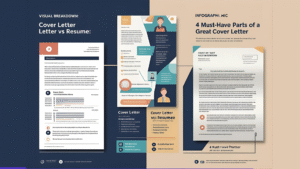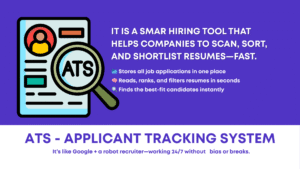Are you ready to uncover the hidden pitfalls that silently kill even the most impressive CVs? Whether you’re a fresh graduate or a seasoned professional, you could be making critical mistakes that often go unnoticed — even by experienced jobseekers.
These are not just the usual resume mistakes like minor typos or formatting issues, or generic tips like “Keep your resume to one page,” “Don’t lie on your resume,” or “Use a clean font.” You’ve probably heard these advice a thousand times—or watched them in countless YouTube videos.
But in this blog, we reveal 10 things NOT to do on your CV— unique, eye-opening mistakes that are silently holding you back. These aren’t your usual CV tips. They’re hard truths from hiring managers, recruiters, and ATS behavior data.
Let us dive into these 10 things NOT to do on your CV:

1. Avoid Fancy Resume Designs Like Skill Bars, Graphs, or Star Ratings:
Your resume should help you get selected, not just look good. Many people use fancy designs with colors, tables, icons, and stars to show their skills — but this can hurt your chances.
Most companies use Applicant Tracking Systems (ATS) — special software that reads resumes. These systems don’t understand graphics or creative designs. So, if your resume has skill bars, star ratings, charts, or columns, the system might not read it at all. That means your resume could be rejected before a human even sees it.
Also, giving yourself 5 stars in Excel or 4 stars in communication doesn’t mean much. It’s just your opinion — recruiters want proof of what you can actually do.
Recruiter tip: “A five-star rating in Excel means nothing unless you can show how you used Excel to do real work.”
What to do instead:
- Use words like Beginner, Intermediate, or Advanced to show your level.
- For language skills, use levels like A1 to C2 (these are global standards).
- Keep your resume simple, clean, and easy to read.
Avoid these mistakes:
- Resumes made in Canva or Photoshop
- Two-column layouts or text boxes
- Pictures, logos, or icons
- Fancy fonts or colors
- Star ratings or skill bars
👉 A good resume is not about decoration — it’s about clearly showing your skills and experience in a format that computers and humans can both understand.
2. Don’t Ignore Your Online Profile — Recruiters Check Your LinkedIn:
In today’s hiring process, your resume is only the beginning. One of the most common and costly mistakes jobseekers make is ignoring their digital footprint — especially platforms like LinkedIn and online portfolios.
Fact: According to a 2023 LinkedIn survey, 87% of recruiters admit they check a candidate’s LinkedIn profile as part of the screening process — often before scheduling an interview.
If your CV says one thing and your LinkedIn says another, even a small mismatch can raise red flags about your credibility. Inconsistent job titles, incorrect dates, missing roles, or outdated achievements may lead to instant disqualification — even if your resume is strong.
Here’s how to fix and future-proof your online presence:
1. Make Your LinkedIn Match Your Resume — Exactly:
Your job titles, dates, companies, and responsibilities should align perfectly. Even a slight mismatch in employment periods can create confusion or appear dishonest.
2. Update Your LinkedIn & Portfolio With Your Latest Work:
Share your recent projects, certifications, promotions, or achievements. Recruiters are looking for proof of progress and performance, not just a list of past roles.
3. Expert Tip:
- Add keywords relevant to your target role in your LinkedIn summary and experience section — this improves both human and algorithmic visibility.
- Google your name. What shows up? Old blog posts, public forums, or social media content that doesn’t reflect your current professionalism should be removed or made private.
- Recruiters often search your name to get a sense of who you are beyond your resume.
4. Use a Professional Email That Matches Your Name
Avoid using email addresses like rockstar_boy22@gmail.com. Stick to formats like firstname.lastname@email.com. This tiny detail adds to your credibility and creates a good first impression.
What to Avoid:
- Using outdated or incomplete LinkedIn profiles
- Having different job dates on LinkedIn vs. your CV
- Skipping project links or portfolio updates
- Leaving public, unprofessional posts online
- Using inconsistent names or usernames across platforms
Why This Matters:
Hiring managers now use LinkedIn as a trust-checking tool. A well-maintained profile builds credibility, shows attention to detail, and gives them more reasons to trust you. Ignoring this step could mean losing out to candidates who took the time to align and optimize their digital footprint.
In short: Treat your online profile like an extension of your resume — because in the eyes of a recruiter, it absolutely is.
3. Don’t Avoid Quantifying Achievements — Numbers Speak Louder Than Words:
When writing your resume, don’t just list what your job was — show what you actually achieved. Instead of saying what you were “responsible for,” talk about the results you delivered.
For example:
❌I was responsible for sales and customer service.
✅ I increased sales by 30% in three months by improving customer service.
See the difference? One is vague. The other proves your value.
Also, try not to use common buzzwords like “team player,” “hard worker,” or “excellent communicator.” These words are used by almost everyone and don’t really show what makes you special. Instead, give real examples that prove those qualities.
For example:
✅ Led a team of 6 people and completed a project 2 weeks before the deadline.
This shows you’re a team player and a strong leader — without saying it.
Tip: Always try to include numbers, percentages, or results when you talk about your work. This makes your achievements more clear, believable, and impressive to recruiters.
4. Don’t Add a Career Objective That Says Nothing – Use a Professional Summary:
Imagine you walk into a room full of hiring managers and say, “I am seeking a challenging role where I can grow and use my skills.”
That might sound nice and professional, but it doesn’t tell the recruiter what makes you special or why they should hire you. In fact, this is one of the most common — and harmful — resume mistakes. It’s boring, vague, and focused only on you, not the company.
Think of the top one-third of your resume like a billboard on a highway.
If it doesn’t grab attention in seconds, the recruiter scrolls past — and your chance is gone.
That’s why, instead of writing a career objective, you should write a professional summary.
A Professional Summary is like your best sales pitch in 2–4 lines.
This is your chance to show who you are, what you’re great at, and what value you bring to the company.
Make your profile summary short, powerful, and tailored to the job:
Include:
- Your job title or role
- Years of experience
- Your key expertise or industry
- A major result or achievement
- Relevant tools, platforms, or skills
For example:
“I am a Marketing Analyst with 5+ years of experience in digital ads, SEO, and data-driven campaigns. I increased website conversions by 42% using A/B testing. Skilled in Google Analytics and CRO strategies.”
This example shows experience, proven results, relevant skills, and is clear, specific, and aligned with the job role.
5. Don’t Use Passive Voice and Vague Phrases in Your Resume:
Be clear, confident, and direct — don’t use confusing or weak sentences.
Imagine you’re an HR manager reading the following lines on a resume:
- “I was involved in various administrative activities.”
- “I assisted with marketing efforts as needed.”
- “Tasks were handled as per instructions.”
These sentences sound vague and unimpressive, right?
You can’t tell what the candidate actually did or how well they performed.
👉 This is exactly what happens when you use passive voice and unclear phrases — they hide your value and weaken your achievements.
Now, compare them to these examples:
- “Managed office scheduling and coordinated meetings for 5 senior executives.”
- “Created social media content that increased engagement by 60% in 3 months.”
- “Processed 200+ invoices weekly with 99.8% accuracy.”
See the difference?
These statements use active voice, show clear responsibilities, and highlight real, measurable impact.
That’s exactly what recruiters want — clarity, confidence, and results.
Why passive voice and vague lines hurt your resume:
- They make your role sound small or unclear
- They leave recruiters guessing about what you actually contributed
- They feel generic, like you just copied a job description
- They fail to show your strengths or achievements
What To Do Instead: Make Every Line Count:
Use active voice, strong action verbs, and specific results.
Start each bullet point with words that show leadership, ownership, or achievement.
Powerful Action Words to Begin With:
- Led – Shows you took charge
- Improved – Proves you made things better
- Built – Highlights what you created or developed
- Managed – Reflects responsibility and control
- Delivered – Shows outcomes or results
- Streamlined – Implies efficiency and smart processes
- Resolved – Demonstrates problem-solving skills
Avoid Weak or Vague Starters Like:
- “Responsible for…” – Too passive; doesn’t show what you did
- “Worked on…” – Doesn’t explain your role or results
- “Assisted with…” – Okay only if followed by a measurable outcome
👉 These vague openers make your resume sound generic — like you just followed instructions. Instead, own your actions and show your impact.
Real-world example — Weak vs. Strong Resume Line:
❌ “I Was responsible for answering customer calls.”
✅ “I Answered 50+ customer calls daily and resolved 90% of issues on the first call.”
The second line is clear, measurable, and shows you made a difference.
6. Don’t Use Irrelevant Information in Your Resume:
Adding unnecessary personal details is one of the 10 things NOT to do on your CV. Information such as marital status, religion, or a headshot is not only outdated but can also lead to unconscious bias — which may hurt your chances without you even realizing it.
Listing obsolete tools like MS-DOS or Adobe Flash signals that your skills may not be current. Similarly, including irrelevant skills such as “Typing 50 WPM” for a marketing role adds no value and distracts from what truly matters.
Many people also include:
- Hobbies that don’t relate to the job
- Very old jobs or school-level awards
- Statements like “References available upon request”
These act as fillers and dilute the impact of your resume.
What you should do instead:
- Cut anything older than 10–12 years, unless it directly supports the role you’re applying for
- Leave out your GPA, unless you’re a fresher or applying for an academic/graduate role
- Add personal interests only if they align with the company’s values or culture
- Focus on skills, experience, and measurable results
- Use a concise, tailored professional summary — not a personal biography
Overall – Stay focused. Every line should strengthen your professional story.
7. Don’t Skip Keywords from Job Description in Your Resume:
Keywords are the important words or phrases used in a job description — such as specific skills, tools, job titles, or qualifications.
For example:
If a job description says: “We are looking for a Digital Marketing Specialist with experience in SEO, Google Ads, and content strategy.”
Then your resume should include these exact terms:
- Digital Marketing Specialist
- SEO
- Google Ads
- Content Strategy
But don’t just list them randomly — use them naturally in your work experience, skills section, and professional summary.
These days, most companies use ATS (Applicant Tracking Systems) — software that scans your resume before a human ever reads it. These systems are programmed to look for specific keywords from the job description.
If your resume doesn’t include those keywords, it may be automatically rejected, even if you’re fully qualified.
That’s why skipping keywords is a critical mistake — and one of the top 10 things NOT to do on your CV.
What happens when you skip keywords?
- The ATS thinks your resume is not relevant
- You may never reach the interview stage
- Your skills and experience stay invisible to the recruiter
- It appears you didn’t read the job description carefully
Final Tip:
Your resume should reflect exactly what the company is asking for. If the job says “Photoshop,” write “Photoshop.” If it says “Client Relationship Management,” don’t just write “Handled clients” — use the exact terms.
Why? Because in today’s job market, words matter more than ever. Don’t lose a great opportunity before anyone even sees your skills. Use the right keywords — and get noticed.
8. Don’t Copy-Paste the Same Resume for Every Job:
Using the same resume for every job might feel easier and save time. But in reality, it almost never gets you interviews. That’s because every job is different, and recruiters want to see how well your resume matches their specific role.
That’s why it’s very important to customize your resume for each job you apply for.
Why this matters:
Recruiters can easily tell if your resume is copied and sent without any changes.
They can “smell” a copy-paste resume from a mile away — meaning they know when you haven’t made the effort to match your resume to their job post.
When your resume doesn’t match the job, it feels irrelevant — even if you’re actually qualified.
That’s why most generic resumes get rejected.
What do recruiters want?
Recruiters want a resume that is:
- Relevant to the job role
- Matched with the required skills and tools
- Aligned with the job description
- Clear about your achievements that fit their needs
So, you need to tailor your resume — meaning you adjust your summary, skills, and experience section — to fit what the company is asking for in their job post.
Example of How to Do It:
Let’s say a job description says: “We are looking for a Digital Marketing Specialist with experience in SEO, Google Ads, and content strategy.”
Then your resume summary should include these same keywords and also show your results.
Like this:
“I am a Digital Marketing Specialist with 4+ years of experience in SEO, Google Ads, and content strategy. I increased website traffic by 120% and boosted lead conversions by 45% within 6 months through targeted ad campaigns and optimized content strategies. Skilled in managing ad budgets of ₹5–10L/month and improving ROI by 30%.”
Why this works:
- It uses the exact same keywords from the job post (SEO, Google Ads, content strategy)
- It clearly shows your job title matches theirs
- It adds real numbers and results, which make your resume more powerful
It proves you’ve done similar work — so you look like the right fit.
Things You Should Avoid:
- Sending the same resume to every company without changes
- Copy-pasting from old or unrelated job descriptions
- Mentioning skills or experience that don’t match the job
- Ignoring the exact keywords used in the job posting
Final Tip:
Think of your resume like a reply to a question — and the job post is the question.
If you give the right answer, you’ll get a callback.
So always ask yourself:
“Does my resume match what this company is asking for?”
If yes — you’re more likely to pass ATS software and also impress the human recruiter.
9. Don’t Overlook File Naming and Format Errors:
Many jobseekers spend hours writing and improving their resume, but forget to check something very simple — the file name and file format of their resume before sending it.
It might seem like a small detail, but this is one of the most common and damaging resume mistakes. A poorly named or wrongly formatted resume can make you look unprofessional — or worse, it might not even get opened.
Why file name and format errors are a big problem:
- If you name your file something like “Resume_Final_2023.docx” or “MyCV.doc”, it looks messy, lazy, and unclear.
- Recruiters receive hundreds of resumes and save them in folders. If your file name doesn’t have your name or job title, it becomes hard to find or track for recruiters.
- If you send your resume in a format like .pages (Mac) or .odt (OpenOffice), some recruiters — especially those using Windows — may not be able to open it at all.
Sending your resume in .doc or .docx (Word format) can cause layout problems when opened on different devices, especially phones or older computers. This can make your resume look broken or unprofessional.
What to do instead (step-by-step):
- Use a clean and clear file name that includes your full name and job title.
- Always send your resume as a PDF, unless the recruiter specifically asks for another format.
PDF files are easy to open and keep your design and formatting intact on any device. You can the following file format:
👉 YourFullName_JobTitle_Resume.pdf
For Example:
If your name is Deepak Sharma and you are applying for a Digital Marketing position, your resume file name should be:
👉 DeepakSharma_DigitalMarketer_Resume.pdf
This looks clean, professional, and clear. The recruiter can identify you and your role instantly — even without opening the file.
Final Tip:
Think of your resume file like your first handshake with the recruiter — it should be neat, professional, and easy to remember.
Even if your resume content is great, a bad file name or wrong format can ruin your first impression or make your resume unreadable.
So before clicking “send,” always ask yourself:
- Is my resume file name clear?
- Is the format safe and professional (PDF)?
- Will the recruiter instantly know who I am and what role I’m applying for?
10. Don’t Overlook Proofreading and Consistency in Your Resume:
One of the 10 things NOT to do on your CV is sending your resume without proofreading. According to a CareerBuilder survey, 77% of hiring managers said they would eliminate a resume with obvious spelling or grammar errors — even if the candidate had strong qualifications.
In another study, 59% of recruiters said that inconsistency in formatting made them less likely to call a candidate.
This means proofreading isn’t optional — it’s expected.
Generally, recruiters spend just 6–8 seconds scanning a resume on average. If they spot a spelling mistake, missing period, inconsistent font, or a mix of past and present tenses — it sends a clear message:
👉 “This person doesn’t pay attention to details.”
In roles where communication, accuracy, or professionalism is key — this can cost you the interview.
What You Should Do:
- Read your resume aloud slowly to catch mistakes
- Use tools like Grammarly or Microsoft Editor for grammar and spell-check
- Ask a friend or mentor to review it with fresh eyes
- Print your resume and check formatting — sometimes errors are easier to spot on paper
- Ensure every detail — from font style to bullet points — follows a consistent structure
Final Tip:
Your resume is not just about your experience — it’s also a reflection of how you communicate, organize, and present yourself. A clean, error-free, and consistent resume says:
- You’re serious
- You’re detail-oriented
- You’re professional
Don’t lose the job because of a mistake spell check could have caught. Take 10 extra minutes — it could make all the difference.
Final Checklist: 10 Things NOT to Do on Your CV
- Avoid Fancy Resume Designs Like Skill Bars, Graphs, or Star Ratings
- Don’t Ignore Your Online Profile — Recruiters Check Your LinkedIn
- Don’t Avoid Quantifying Achievements — Numbers Speak Louder Than Words
- Don’t Add a Career Objective That Says Nothing — Use a Professional Summary
- Don’t Use Passive Voice and Vague Phrases in Your Resume
- Don’t Use Irrelevant Information in Your Resume
- Don’t Skip Keywords from Job Description in Your Resume
- Don’t Copy-Paste the Same Resume for Every Job
- Don’t Overlook File Naming and Format Errors
- Don’t Overlook Proofreading and Consistency in Your Resume
Stay Ahead in Your Career – Join the JobRath Community
If you’re looking to stay updated on the latest industry trends and discover job opportunities that truly match your skills — JobRath has you covered.
Register now for personalized job alerts:
👉 https://jobrath.com/registration-form
Subscribe for expert career tips, job updates & interview guidance:
👉 https://www.youtube.com/@JobsRath
👉 Follow us on social media to stay connected and informed:
👉 Facebook: https://www.facebook.com/jobrath
👉 Instagram: https://www.instagram.com/jobsrath
👉 LinkedIn: https://www.linkedin.com/company/jobrath
About Author
Mohd Tauheed
I am a seasoned content and advertising professional with 8+ years of proven experience in content creation, digital marketing, and SOP writing. My background spans both healthcare and consumer domains, where I have developed impactful promotional content, SEO-optimized articles, ad copy, and campaign strategies across print, digital, and social media platforms. I bring a strong command over English and Hindi writing, hands-on experience with Facebook Ads, Google Ads, and meta analytics tools, and a record of managing content for diverse industries including healthcare, education, IT, and interiors.
Explore More Recent Posts

What Is US Healthcare Training – And Why It’s the #1 Career Game-Changer for Indian Jobseekers in 2025?
Are you stuck in a low-paying BPO job—or unsure where your degree is taking you? U.S. Healthcare Training empowers Indian graduates to launch high-paying international careers—right from India. In just 3 months, learn Medical Billing, AR Calling, and Denial Management. No medical degree required. Get job-ready for top healthcare BPO roles in Noida, Pune, and beyond.
Start your breakthrough today—your career upgrade begins here.

What Is a Cover Letter? 7 Reasons Why It Matters More Than You Realize (And How to Write One That Actually Works)
A cover letter is not just a formality—it’s your best shot at showing who you really are beyond bullet points. While your resume says what you’ve done, a great cover letter tells why it matters—and why you’re the right person for the job.

What is an ATS? (And Why It’s So Important for Job Seekers!)
An ATS is a smart computer program that helps companies hire people. It collects all the resumes, reads them quickly, and picks the best ones. If you’ve applied for a job, your resume probably went through an ATS before a person saw it. That’s why learning how ATS works can help you get noticed and get hired.

10 Things NOT to Do on Your CV (Avoid These Critical Resume Mistakes to Get Shortlisted Fast)
Not getting interview callbacks? You may be making invisible CV mistakes. Discover the hidden errors most professionals overlook and how to fix them for faster results. Read now to uncover the 10 Things NOT to Do on Your CV.

Why Your Resume Is Not Getting Shortlisted – Top Resume Mistakes and Proven Fixes That Get Results
Are you struggling to get interview calls? Your resume might be the real reason. Most job seekers make common resume mistakes that go unnoticed—and cost them big opportunities. In this eye-opening guide, we will uncover exactly why your resume is not working and explore proven, easy-to-implement strategies that help you get shortlisted faster.
Do not let your dream job slip away—click to read now!

